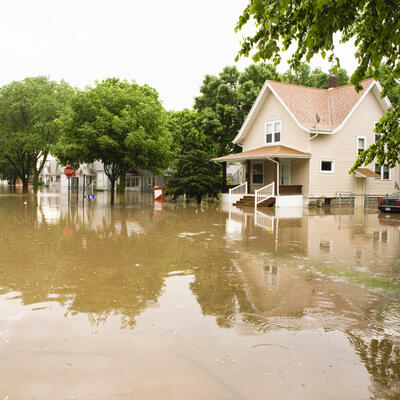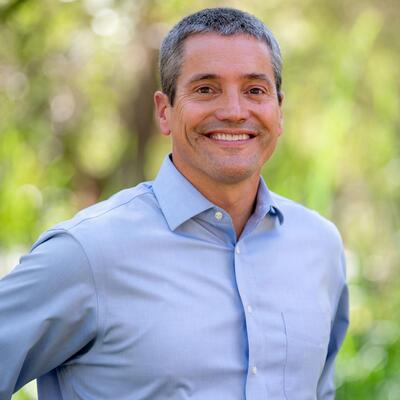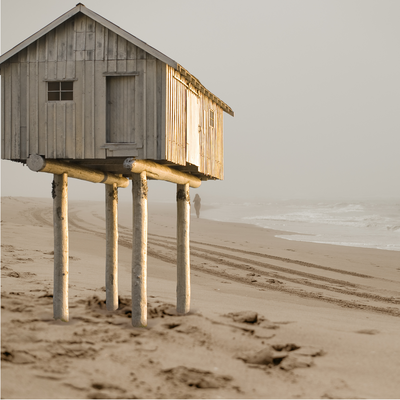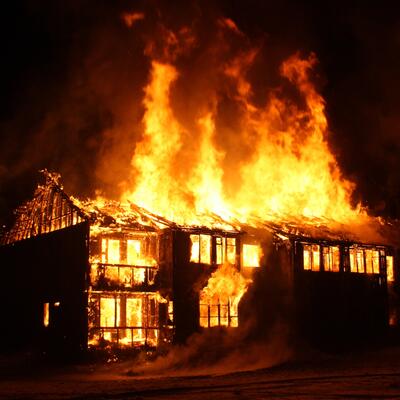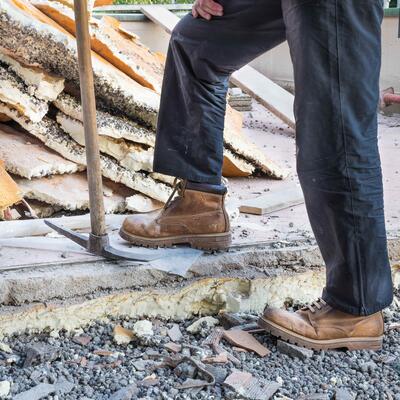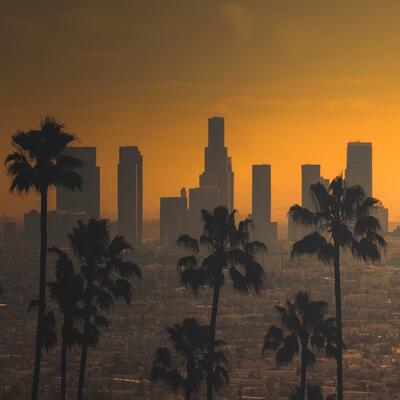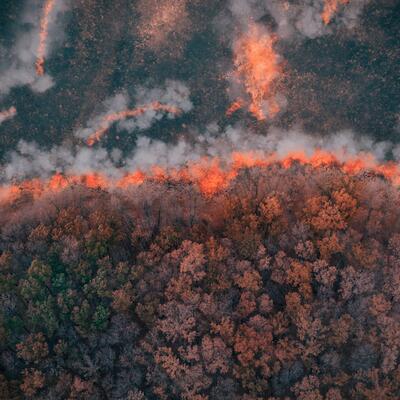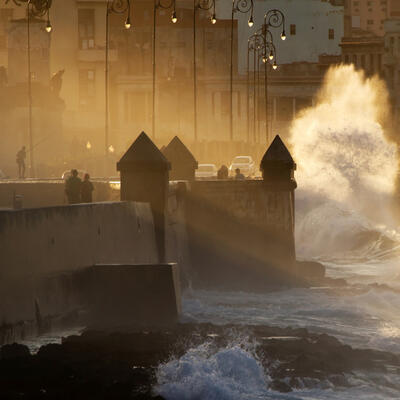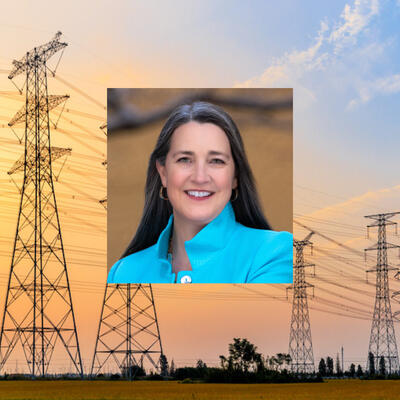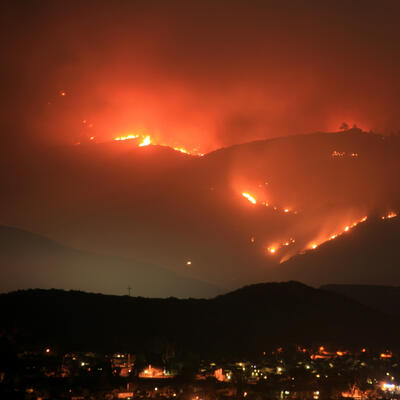
Living With Fire
Guests
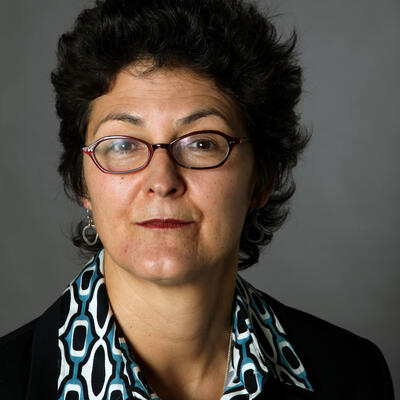
Julie Cart
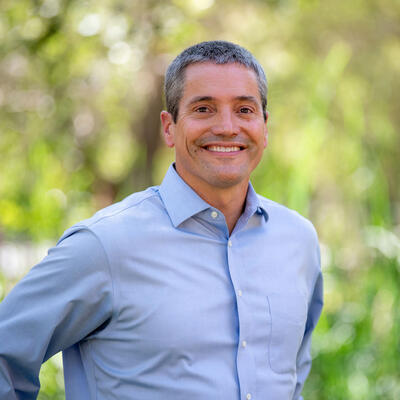
Wade Crowfoot
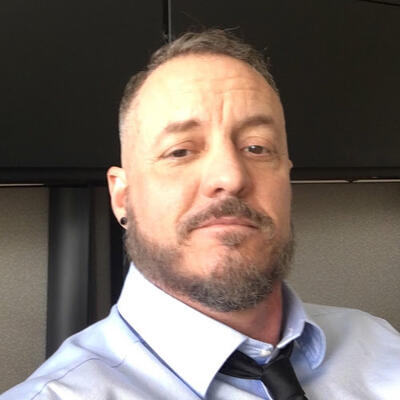
Leroy Westerling
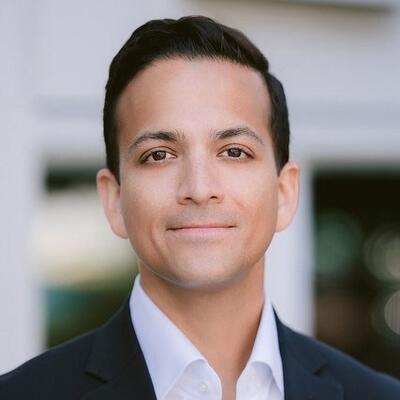
Vin Gupta
Summary
“Wildfires have historically been a natural part of California's ecology,” says Wade Crowfoot, California’s Secretary of Natural Resources. “Meaning we have wildfires every year from time immemorial.”
But a lot has changed over the past 150 years, thanks to human intervention. Burning fossil fuels and suppressing the burning of forests over the past century have led to larger, more frequent and ever-more catastrophic wildfires. This fire season is on track to be the worst ever, with forests burning throughout the western United States. California alone has already seen over three million acres burn, with six of the top 20 fires in the state’s history occurring this year.
Burning trees release carbon dioxide. California’s fires now are so big and fierce that they threaten to erase the state’s progress in reducing greenhouse gas emissions.
“So not only do we need to control these catastrophic wildfires to protect people and communities’ natural places,” Crowfoot continues, “we need to do it to meet our carbon our climate goals.”
Winds have pushed smoke and ash into communities hundreds of miles away, darkening the skies in San Francisco and other cities. Even for those miles from the flames, the smoke from raging wildfires presents a severe health hazard in the age of coronavirus.
"How and when exposure to wildfire smoke increases the likelihood of infection with COVID-19, we’re still trying to figure that out," says Vin Gupta of the Institute for Health Metrics and Evaluation at the University of Washington. "But there is a clear symmetry between exposure and the likelihood of infection."
Leroy Westerling of University of California Merced says that the changing climate has exacerbated fire conditions over the past century.
“California has this highly variable climate and the fuels are there” to produce catastrophic wildfires, says Westerling. “And if anything, the reality tends to outpace the models and we’ve seen that time and again…and we’re saying it will become very common, potentially by midcentury.”
But it didn’t take that long, as it turns out.
“Now we’ve had it in 2020. We didn't have to wait for another 30 years to get there.”
Additional Interview:
Lenya Quinn-Davidson, Director of the Northern California Prescribed Fire Council.
Related Links:
Cal Fire: 2020 Wildfire Map
Northern California Prescribed Fire Council
California struggles to find help fighting wildfires (CalMatters)
Wildfires in the West (New York Times)
Wildfire Smoke and COVID-19 (CDC)
This episode was recorded in August 2020.
Full Transcript
Greg Dalton: This is Climate One. I’m Greg Dalton.
Greg Dalton: Burning fossil fuels and suppressing the burning of forests over the past century have led to larger, more frequent and ever-more catastrophic wildfires. And burning trees release carbon dioxide. California’s fires now are so big and fierce that they threaten to erase the state’s progress in reducing greenhouse gas emissions.
Wade Crowfoot: So not only do we need to control these catastrophic wildfires to protect people and communities’ natural places, we need to do it to meet our carbon our climate goals.[:10]
Greg Dalton: And even for those miles from the flames, the smoke from raging wildfires presents an extra danger in the age of coronavirus.
Vin Gupta: How and when exposure to wildfire smoke increases the likelihood of infection with COVID-19, we’re still trying to figure that out. But there is a clear symmetry between exposure and the likelihood of infection. [:14]
Greg Dalton: Living with Fire. Up next on Climate One.
---
Greg Dalton: How bad can California’s wildfires get?
Climate One conversations feature energy companies and environmentalists, Republicans and Democrats, the exciting and the scary aspects of the climate challenge. I’m Greg Dalton.
MONTAGE: [1:04]
IN: “....tonight, the desperate battle to contain California’s historic fires...”
OUT: “Residents here know a painful reality - that fire season is just getting started.”
Greg Dalton: It’s not only California that’s burning. The 2020 fire season could go down as the worst on record, as millions of acres burn throughout the west, from Washington to Montana and down through Colorado and New Mexico.
On today’s program, we’ll explore the impact of wildfires on public health, the economy, and the environment in the age of COVID, as well as the implications for climate change. And we’ll talk about how California is addressing these and other fire-related challenges.
Joining me now are Wade Crowfoot, California Secretary for Natural Resources, and Julie Cart, environmental reporter with Cal Matters. While three of California’s largest fires of all time occurred this year, Crowfoot points out that fire is nothing new to the golden state’s forests.
PROGRAM PART 1
Wade Crowfoot: Wildfires have historically been a natural part of California's ecology. Meaning we have wildfires every year from time immemorial. That being said a lot of changes have occurred over the last 150 years that have exacerbated our wildfire threats each wildfire season. And when you add on top of that climate change and the impacts it brings, we now have catastrophic fires in ways that we never had them in the past.
Greg Dalton: And Julie is the state doing a good job preparing for these wildfires? Because it’s been the last five years or so that they’ve really grown in size and impact. How good is the state doing in terms of preparing for these?
Julie Cart: Well, Greg, I would say the growth that is most pertinent to your question is the extension of the fire season, which is now about two and half months longer than it used to be. There was a time when everyone got to catch their breath. They got to work on equipment, folks sent them off to do other things. And most importantly do that fire mitigation work which is cutting trees, cutting brush, burning trees, burning brush and doing things like that. There's no time for that now.
So, there is no fire season there is no down time and so that's to contextualize. You can always, always from where I sit in the cheap seats say that people could do more but it cost a ton of money and it’s gonna require residents in California in the West to accept and actually understand burning and cutting. And that's very, very difficult for people to look at. We’re kind of reptilian brain hardwired to not like trees burning, or people cutting trees, but that's what it’s gonna take. And there's just huge complications in both of those involving money and time and everything else.
Greg Dalton: Wade Crowfoot, let’s talk about the cost of this. California's in a big recession the global recession. Some of the resources plan for firefighting have been pulled back, pulled off the ballot in November. How this gonna be paid for?
Wade Crowfoot: Well, I think we need to be clear that doing nothing to protect ourselves and our natural places from wildfire will be more expensive than taking preventative measures and strengthening our response. In other words, we have to invest in building our resilience from these catastrophic wildfires. The good news is that recent years have seen major increases of investment open to fire response side -- more aircraft more helicopters more firefighters more engines -- but also on the prevention side. So more prescribed burning, more forest thinning, more community fuel breaks, more home hardening. The challenge as Julie noted is this wildfire threat is growing so significantly we’re struggling to keep up investments with the growth and the severity of the threat.
===============
Greg Dalton: It may sound counter-intuitive to intentionally start a forest fire. But prescribed burns, controlled burns, cultural burns—these are all names for the ancient practice of routinely setting the land on fire in order to prevent larger fires. Climate One’s Andrew Stelzer spoke with Lenya (LAIN-yuh) Quinn-Davidson, Director of the Northern California Prescribed Fire Council.
BEGIN CLIP: LENYA QUINN-DAVIDSON [:2:45]
Andrew Stelzer: In the early 1900’s, there were more and more Californians living out in wild lands. The forests were considered an economic engine, and fire became seen as the enemy, to be suppressed at all costs. Lenya Quinn-Davidson says with that cultural change, traditional forest management techniques were mostly discarded.
Lenya Quinn-Davidson: For millennia, people used fire to create the conditions that they needed to survive in California. And we've gotten out of sync in that way here…and the result after more than a hundred years of keeping fire off the landscape is that our forests are incredibly dense. The species composition has shifted. We have a lot of young trees growing up under our bigger trees. A lot of our bigger trees have been removed, and a lot of our open prairies and meadows have filled in with trees and brush, and we're just living in a landscape that has much more biomass on it. And in a fire context, that equals fuels and that's what fuels fire.
Andrew Stelzer: Over the past few decades, the experts have realized the error of their ways. And after a deadly few years, Cal Fire, Governor Newsom and even the US Forest Service are on board with increasing prescribed fires in California. But it will take time for the institutions to catch up with what nature needs.
Lenya Quinn-Davidson: I think in California, we're used to thinking that we're ahead of the curve on things and in the prescribed fire realm, we are definitely not ahead. We are behind.…Historically California may have had even 4 million acres a year burn in wildfire…Cal fire has a statewide target of 20,000 acres a year…we're nowhere near the scale of prescribed fire that needs to be getting done.
Andrew Stelzer: Quinn-Davidson says she’s encouraged by the spread of regional fire councils like hers, and even grassroots community groups that are conducting prescribed burns on their own; year round, as a routine part of their lives.
Lenya Quinn-Davidson: Fire's becoming part of our state identity and people in California are becoming more familiar with fire. Most people know what prescribed fire is. Most people know that fire has some kind of role in our forest and in our landscape. And that's pretty different, I think, than it was 20 years ago...We're starting to understand that yeah, fire is a part of California's future and we do need to get used to a certain amount of smoke, and working on this year round and not just worrying about it during fire season. And that's how we're going to move toward a vision of actually living with fire here. We're not getting rid of it, and I think that's becoming increasingly clear.
END CLIP
Greg Dalton: That was Lenya (LAIN-yuh) Quinn-Davidson, Director of the Northern California Prescribed Fire Council. We’re talking about wildfires in California with Wade Crowfoot, California Secretary of Natural Resources and Julie Cart, a reporter with CalMatters. I’m Greg Dalton.
===========
Greg Dalton: Wade Crowfoot, there’s been a lot of talk about how California is responding to these fires and COVID has affected evacuation plans and also the firefighting force. Prisoners have been let out of prisons, therefore fewer of them are available to fight fires. COVID has exposed a lot of vulnerabilities in our community. Your agency oversees CAL Fire. Is it right that California relies on prison labor to fight fires?
Wade Crowfoot: Well look, the use of prisoners who volunteer to join the wildfire fight in ways that can reduce their sentences I do think makes sense. And our firefighting crews from the prisons has been an important part of firefighting in California. And we’re appreciative for the contributions that they make. And in some cases that experience has allowed them to leave prison and find work in a similar field. So, it’s part but only part. We rely on our state firefighters in Cal Fire, but we also have our partners in the U.S. Forest Service. We also have a really extensive mutual aid network where we support each other by locals coming to fight fires in other communities. And then this summer we’ve been supported by many states. So these are all sort of pieces of the puzzle or parts of our effort to fight fires and they all play an important role in protecting our communities in years like this.
Julie Cart: Yeah, there’s a long tradition in mutual aid in the fire service. Sometimes in California we think of it as within the state where county and local fire districts would help out. And because of the state’s patchwork of land ownership right now there's fires and will be into future, Forest Service, Park Service, Bureau of Land Management, Bureau of Indian Affairs. So, there's always cooperative work. Again I’m gonna back to the fire season problem. Usually early in the year which we’re still considering this is considered early in the California fire season, we’re not asking for resources, we’re not requesting resources from regional neighbors. With California fires, with the kind of urgency that they have the size and the intensity, we now have to go to states like Arizona and Colorado and Nevada and Montana and everywhere else where they also have fire. So, they can’t help us there's nothing left for them. You know, so they have to protect their own state. So that's the problem. When we start asking in the past we've asked for help in September, October, when our big wind driven fires start happening, especially in Southern California. By then the fires are out or they’re very minimal, so states can afford to send crews and equipment. Now when we’re asking so early in the season and all the West is on fire there's just -- it’s too thin.
Greg Dalton: And Wade Crowfoot is this just gonna be an accepted part of life there’s no way out of this. We’re just gonna have to accept wearing masks a few weeks a year in the fall in the Western United States because of wildfires?
Wade Crowfoot: Look, our California Governor Newsom put it best, which is if you want to understand the impacts of climate change, come to California. You know, winter and summer temperatures are rising. Our snowpack is dwindling, droughts are becoming more persistent and punishing. And as a result, wildfire threats are getting worse. That being said, we can’t resign ourselves to doing nothing amidst this reality. We have to continue to lead a global effort to combat climate change, reduce our carbon pollution and build our resilience. You know, Greg, you and I have talked about climate adaptation and it used to be sort of perceived as a wonky plan exercise for coming decades. But we know that adapting to these impacts of climate change is a matter of public safety right now. So, no, I don't think we should become resigned to the challenges we faced with the next couple of years. And I'm excited that we’re taking actions to actually strengthen and protect our communities and natural places from these impacts.
Julie Cart: There’s another really compelling reason to get on top of fires and it has to do with carbon and air quality and not only California's goals for reducing greenhouse gases, but its impact on our neighbors. Fires do, it’s like a triple whammy. They reproduce carbon, black carbon the worst kind they put that in the air. They're taking away trees which are carbon sinks which pull carbon out of the air so we lose that value that the trees and forest offer. And then dead and dying trees lie on the forest floor and scientists tell us that they can keep expelling carbon for 250 years. So, there is every reason from a resource from a public health, public safety, but also for this state and others to meet greenhouse gas reduction goals and for air-quality issues which are quite real. There's every reason to pay a lot of attention and do whatever it takes to deal with these fires.
Greg Dalton: Wade Crowfoot, what happens after the fires are put out? A lot of risk there as Julie pointed out. And is there any effort to create an economic case for getting dead partially burned wood out of forests and using it for some productive purpose?
Wade Crowfoot: Yeah. Well, responding to these wildfires is expensive, but recovering from these wildfires, bringing communities and natural places sort of back to so-called normal, is very expensive. We are spending billions of dollars removing sort of hazardous materials that have melted off burned homes from wildfires over the last couple of years, billions of dollars, and will continue to do that. Which is why it’s so important to reduce the severity, the size of these wildfires. We absolutely need to get more of these so-called fuels these dead trees out of the forest that worsen this catastrophic risk and we need to build incentives to actually do that. So, a lot of folks in our state are really excited about building markets for wood products to use these smaller diameter trees these dead and dying trees for wood products. And that is showing some early promise to actually create an incentive to get these dead trees out of the forest create jobs and naturally recycle that wood for productive economic use.
Greg Dalton: Wade Crowfoot, do we need to change the way we interact with this wildland urban interface? More people moving into the foothills, etc. do we need to change the way we’re interacting with nature because these fires are so vicious and deadly?
Wade Crowfoot: Well, we certainly have to recognize the risk. One in four Californians lives in that wildland urban interface or extreme high hazard zone of wildfire. And I think a lot of folks don't fully recognize that. And if you do live in those zones there's a lot that you need to do to protect your home and your families from wildfire. Defensible space, home hardening. So first of all, we have to do a better job as Californians protecting ourselves if we live in those areas.
Our rural counties are some of our most economically challenged communities in the state. And as we need to bring on housing, they envision building communities and bringing folks into those counties as an important opportunity to strengthen the economies of those counties. The challenge is of course, that those new homes that are built are often in those high hazard zones. And in California, local land-use decisions are made by local government not state government. State policymakers are really trying to navigate how we can create incentives for economic growth and housing development within existing cities, but in ways that don't punish rural economies that also need to grow.
Julie Cart: And Greg, that drives the cost. The priorities are life and property to begin with for firefighters. So, if we didn't live in those areas, we wouldn't have such an imperative, an immediate imperative to aggressively attack and put out these fires. I mean there are fires in Alaska that burn for months and months and months. They perform a service they’re not really hurting anyone. I mean, there are some resource issues but that's the problem. We can allow fires to burn in particular areas when they're not threatening people or property. But you have to put out those fires. It is an urgent I mean clearly that's the least we can expect from government. So that just puts everybody behind the eight ball because we’re all in those areas, and all those fires occur there as Wade mentioned 95% of our fires are human caused and so people are around so you have to put them out and it becomes a cycle that is really inexorable and very difficult to get out of.
Greg Dalton: In past years some of these fire studies have suggested that these fires could blow away all of other California’s other climate progress measures. All the move toward cleaner energy and cleaner cars these wildfires are erasing the state’s progress.
Wade Crowfoot: Yeah. And again, you know, wildfires are natural to California's landscape and they are part of our ecological cycle. So, our goal cannot be to rid the state of wildfires. However, to your point these catastrophic wildfires the size of which we’ve never seen before emit so much carbon dioxide, so much unhealthy air pollution, that they really do present a major threat to making progress to reducing our overall greenhouse gas pollution in the state. So not only do we need to control these catastrophic wildfires to protect people and communities’ natural places we need to do it to meet our carbon our climate goals. And so, it really involves not again erasing wildfire from the landscape, but taking some proactive measures to really allow wildfires to burn each summer but in ways that are much more natural than what we’re experiencing today.
Greg Dalton: As we wrap up here I wanna just end on sort of the personal note. Wade, I’ve been living and breathing climate full-time for about 13 years and there’s something about this year that really got to me. The heat and then the fires and like I wanna run these air filters, but then I shouldn’t run the air filters because that's adding electric load to the grid and we're not supposed to do that. It just felt like on top of COVID it just felt like too much. How much of this can we take and how are you dealing with it?
Wade Crowfoot: Well, 2020 has been a huge challenge I imagine for everyone across the country and across the world. The pandemic brings such uncertainty and anxiety to our lives. You add on top of that record-breaking heat waves. Where I live in Sacramento, we were looking at heats of over 110 for multiple days and then air quality and from the fires that really doesn’t allow much time outside and you really begin to feel trapped. So, this has been a major challenge absolutely that you know I think we’re all dealing with on a professional level but more importantly a personal level too. I have a six-year-old and my six-year-old is now accustomed to wearing a mask when we go outside. Remarkably, this wasn't the first time in 2020 she had that; we pulled the mask out from one of our boxes because we’re living in the Bay Area and she had a mask for wildfires.
So, I think what wakes me up in the morning is we can't resign ourselves to this fate. This can’t become the new normal. We need to adapt in ways that continue to allow us to live our lives and protect our communities and our families. This doesn't mean that we can erase or completely reverse the impacts of climate change. Those impacts are here. But there's so much more that we can do as we’re tackling global climate pollution to protect our communities from the experiences that we’re having here in California this year.
---
Greg Dalton: You’re listening to a Climate One conversation about wildfires in the American West. Coming up - looking at the past to understand the future.
LeRoy Westerling: We can go back about a century; the modern satellite enhanced record that really gives us a lot more detail only goes back to 1984...But there's some key sorts of things that we can look at to really understand how fire is changing. [:15]
Greg Dalton: That’s up next, when Climate One continues.
---
Greg Dalton: This is Climate One. I’m Greg Dalton, and we’re talking about wildfires in the American west. Joining me now is Leroy Westerling, Professor of Management of Complex Systems at University of California, Merced, where he researches climate and wildfire interactions.
As my previous guests pointed out, fire in this part of the country is nothing new - California has always burned, and it always will. As climate change continues to fan the flames with drier winters and longer summers, it does seem like every fire season is the worst ever - but is it really? Westerling offers some historical context.
PROGRAM PART 2
LeRoy Westerling: So documentary records depending on the agency could go back sort of comprehensively to the 70s or 80s, on state lands to the 50s. And then we have longer documentary records in California for large fires in places like Yosemite National Park. We can go back about a century; the modern satellite enhanced record that really gives us a lot more detail only goes back to 1984. So, it really depends what record you're looking out and what kind of fires you’re talking about. But there's some keys sort of things that we can look at to really understand how fire is changing.
It’s true that California has always had a highly variable fire season from one year to the next and that we’re fire prone and get a lot of fire. Right now, we have fire in just about every type of ecosystem in California. It’s about the size of Japan. The population is much less than Japan's but it’s still very dense in some places. And it spans a lot of degrees of latitude and a really extreme elevational gradient from the highest mountain peak in the lower 48 states of the United States to the coast. And actually, in Mojave Desert below sea level is the elevation there. So, there are a lot of different ecosystems here a lot of variety and they respond to climate in different ways. And that means that climate change is having different impacts through different routes in different locations. And so we see changes in the fire season and the type of fire and where we’re getting it that are very much driven by climate change, even when it’s interacting with things like, say the buildup of fuels from a century of fire suppression or lack of investment in aggressive fuels management in Sierra Nevadas, for example.
Greg Dalton: And so there you’re talking about Smokey the Bear, right. We had a history of fire suppression, fires were bad, only you can prevent forest fires. How has that contributed to where we are now?
LeRoy Westerling: Well, so it contributes to an increase in fuels in forest ecosystems especially on federal lands or public lands in California. So, the Sierra Nevada used to burn in mid-elevation much more frequently than it did in the recent past, and that change in the fire rotation or the time between when an area would burn was really affected by fire suppression. And then we got much denser fuel. So instead of having an open canopy with a tree here and a tree there and the fire staying down mostly at the surface and not killing most of the trees, we ended up with this dense forest canopy where the fire is burning in the treetops and killing a lot of trees, a much higher severity fire. And that has been exacerbated by climate change because of a number of things, but primarily one warmer temperatures means more evaporation. So, it’s just a greater urgency. The spring snowmelt is a really important indicator of how severe the fire season might be. And that's affected by climate change, not only because warmer temperatures mean more rain and less snow, but it also means earlier snowmelt for the snowpack that is there. And we live in a Mediterranean climate where the summers are long dry season. And what we’re doing is we’re making that dry season longer by not having snow there on the ground melting late into the spring and early summer, right. And so that just brings the dry conditions earlier and so extends the time when you get a big fire at those higher elevations. That interacts with those fuels. But the fires that you’re reading about today most of the ones that are getting attention are where there’s people. And that’s lower elevations and those are typically not federal lands and they’re typically a mix of different types of vegetation. Grass, shrubs and smaller pieces of forest.
And so, things that we experienced like the Camp Fire in Paradise or the Tubbs Fire in Santa Rosa or the Thomas Fire in Ventura these are all really very impactful on areas where people lived. And they were all late in the year, the Thomas Fire was in December; it was the first megafire and the largest fire in state history at that time and it burned in December after no real significant precipitation until then. The Paradise Fire again the conditions were anonamously very dry for that time of year it was November they were as dry as the driest summer conditions that we’ve seen since the 1970s. And really only comparable to dry summer conditions that occurred in the last several years of warming, right. So, it was really extreme conditions late in the year and again very strong winds. So, there's different patterns taking place and so we see more and more fire in California and its related to these complex interactions between timing, drying and the type of precipitation that you get and then how the landscapes been managed in the past.
Greg Dalton: So, what I heard there is that this is a big year, and the worst part is yet to come with the higher winds. Usually September, October, even into November. So, this was quite an opening act for California's 2020 fire season.
LeRoy Westerling: And even the fire in Santa Cruz, San Mateo County the CZU August Lightning Complex is what it’s being called is very large by a recent historical standard for that region. We did an exercise with the County of San Mateo for their climate: vulnerability and adaptation planning in the last two years where we looked at our simulations of wildfire over California that were done for the state climate assessments. And we said to them, hey, you know, by midcentury, the conditions for really large fires in this region increase dramatically in frequency. And let's try to map those out and do some scenarios, some storyboarding to think about how you do emergency management planning, what the impact would be on transportation and other types of infrastructure. How you’d evacuate people, how you’d fight a fire like that. We were simulating them at course special resolution so like 6 km and we had to get it down to lines drawn on a map.
So, we have this interactive discussion with all the fire chiefs and emergency management personnel and county officials. And we drew these maps to mimic the conditions but they were coming out in the simulation but with the knowledge of that community about where the ignitions happen, where the prevailing winds would drive a fire, where the fuels will be available and give you a fire that large. And we had several different sizes of fires that we storyboarded out like that. And the largest one, the worst-case scenario, looks just like this CZU complex. And at the time people were saying to us. How could this happen here, even by 2050, with a little more warming, right. It’s not reasonable because we have this moist marine air layer that comes in every night and wets down the fuels and we just don’t think that we get to see a fire that big. And we've already had it now in 2020 not 2050.
Greg Dalton: So, you’re saying that the fire that’s burning has burned this summer is something that experts didn't think could happen for another 30 years?
LeRoy Westerling: No, I wouldn't say that we didn't think it could happen because California has this highly variable climate and the fuels are there. And if anything, the reality tends to outpace the models and we’ve seen that time and again. It’s more that we were saying this is a something that could happen. Just because you haven't experienced it doesn't mean it couldn't happen. And we’re saying it will become very common potentially by midcentury. And they didn't believe that it could become that common by midcentury, and now we’ve had in 2020. We didn't have to wait for another 30 years to get there, right.
Greg Dalton: So how does this play out even if we turned off all the fossil fuels today. Say, there’s a magic switch, you know, if we hit the brakes today. I mean how much momentum is there in the system?
LeRoy Westerling: We’re gonna be warming for a long time to come. If you look at the scenarios, the more optimistic scenarios sort of the mid-case scenarios. They don't just rely on us limiting emissions. They rely on negative emissions. So, the Intergovernmental Panel on Climate Change’s suite of scenarios so as with the midrange ones that everybody thinks would be great if we could end up there. Actually, at this point all rely on us deploying globally at industrial scale technologies that remove carbon dioxide from the atmosphere and fix it in a form that where it becomes inert and it could be sequestered for a long time.
Greg Dalton: So, one of the initiatives that got a lot of attention earlier this year was plant a trillion trees, right. It’s very positive, everybody loves trees, big scale, salesforce, Donald Trump. So, in a world that’s constantly on fire, help me understand planning a trillion trees and is that really gonna absorb as much CO2 out of the atmosphere as we need?
LeRoy Westerling: Well, if you started planting a lot of them here you couldn't guarantee that they’re actually gonna hold that carbon long enough, right. If they burn up in a high severity fire within 100 years all you are doing is giving another pulse of carbon dioxide to the atmosphere right when you really don’t want it. And there’s other places where, you know, you may not have enough water 20 or 30 years from now to sustain trees that you’re planting today. And yet other places where if you look at the climate models they’re gonna start growing trees on their own like say higher latitude in Siberia in places like that as warmer conditions shift that tree belt northward. But putting trees there also means changing the albedo. It's gonna be darker with trees than it is with tundra and that actually is a positive feedback to climate change positive in this case meaning enhancing the climate change increasing the warming rate.
So that's one of the factors one of the feedbacks that they’re looking at in climate models. If you go there and you plant more trees there and we could just say, hey, that’s gonna be a place where trees are growing in the future, you’re just speeding up the feedback.
Greg Dalton: California has been a leader in the country for moving toward a cleaner economy. Lot of other states have done a lot too. But how much can these fires erase all of the work that California does on electric cars and clean electricity and all these other things. How much of that goes up in smoke with these fires?
LeRoy Westerling: Well, so it's not going to negate it, right, if we do a good job on clean energy. I don't have the numbers in my head for California specifically, we did something similar for the Northern U.S. Rockies. The Northern Central U.S. Rockies so from the Canadian border down through Yellowstone. And we calculated just on the back of the envelope if you burned all the trees up in the mountains in one go, you know, it was on the order of magnitude of the anthropogenic or human caused emissions from one year in the lower 48 states. So, and then it would take a while for that to grow back again before you could burn it. So, we’re not talking about something that’s gonna swamp, you know, overwhelm the effects and that of clean energy investments and more efficient appliances and homes and cars and things like that. And that’s just because the scale of human fossil fuel use is so immense, right. But there are other natural reservoirs of carbon on the globe that do have that potential, right. It’s not trees in arid places like California, it's the carbon in the permafrost in latitudes where you really need to keep an eye on.
Greg Dalton: So, if you look forward California has had a startling devastating start to this fire season, the worst condition where higher winds are yet to come. What’s the path forward, what should we do to reduce the fire risk? We’re not gonna eliminate it in the Western United States, fires burning in Colorado, Arizona, all around the West.
LeRoy Westerling: Well, so a lot of the homes that people are gonna be living in 30, 40 years from now are already built. So, we need to provide incentives to retrofit those homes to make them more resistant to fire. And we need to provide incentives to manage vegetation around them to make them more resistant to fire. That'll help a lot with the communities. The federal government and the state government are stepping up their investments and fuels management in the Sierra Nevada. There’s not a lot of people living up in the mountains there. Most of the homes being lost are down on lower elevations not on adjacent to public forest. And really, we need to unleash the private sector to act in its own interest.
So, where I live, I live in Mariposa, California. It’s a small 1850s gold rush mining town on the way to Yosemite National Park in Sierra Nevada mountains. Both my houses – I think about moving out of one and into another, you know, and they both lost fire insurance. And this is a widespread problem across California. They both have mortgages you can't, you know, be in good standing with your lender without fire insurance, but the companies are all withdrawing from the market here because they don't think they can assess the risk. And the state FAIR plan that's picking up the slack stepping in, in order to protect those banks as well as well as the homeowners, doesn't have any information to assess those either because they don’t even have any proprietary information that the insurers had. They haven’t been in the business that long and they don’t necessarily have all the information on what climate change has already done to those risks. So, a lot of improvement could come from just getting a better grip on what the risks are and what they’re going to be going forward for pricing. And then if people can get rebates on what's going to become much more expensive insurance from after investing in retrofitting their homes and managing the vegetation around their communities that would provide sort of a virtuous cycle where our communities could become somewhat more resistant to fire. Because really, we have to learn how to live with these fires for a long time to come.
---
Greg Dalton: You’re listening to a Climate One conversation about living with fire in the American West. Coming up - facing up to the long-term health impacts.
Vin Gupta: Even fetuses in utero, those residing in moms that have been exposed to high levels of wildfire smoke. Those babies that ultimately end up getting born are seen to have immune disturbances even a decade out. [:14]
Greg Dalton: That’s up next, when Climate One continues.
---
Greg Dalton: This is Climate One. I’m Greg Dalton, and we’re talking about the impacts of wildfires. As forests burn throughout the west, many people wake up to the smell of smoke - even those who are many miles away. For people who live in fire prone areas, as well as for firefighters, breathing smoke-filled air is a regular hazard. What are the long-term health effects of so much smoke?
Vin Gupta is Affiliate Assistant Professor at the Institute for Health Metrics and Evaluation at the University of Washington. Gupta draws a direct connection between exposure to wildfire smoke and increased vulnerability to COVID-19.
PROGRAM PART 3
Vin Gupta: There's been a lot of literature studying the acute effects of wildfire inhalation smoke from wildfires on the human body on individuals both young and old. And what we've seen is that even acute exposure, so a matter of a few hours of inhaling unhealthy air quality from a nearby wildfire can impact the immune system, especially the developing immune system. So, our adolescents, even fetuses in utero have been studied, those residing in moms in place that have been exposed to high levels of wildfire smoke. Those babies that ultimately end up getting born are seen to have immune disturbances even a decade out.
And so, there are serious impacts how and when exposure in wildfire smoke increases the likelihood of infection with COVID-19, we’re still trying to figure that out. But there is a clear symmetry between exposure and the likelihood of infection. So, any type of air pollution does appear to actually make the human body more susceptible to infection when you're exposed to the virus.
Greg Dalton: So what that means right now, with these historic wildfires ravaging California is that anyone who's breathing that smoke even for a short period of time is increasing a health effects that may be long-term and possibly their COVID vulnerability, is that right?
Vin Gupta: That’s exactly correct. Before the pandemic there was actually a lot of attention was being paid to the impact of air pollution alone, whether from car exhaust or from a wildfire on the human body. We have long thought that air pollution is detrimental to the human body to the heart, lungs, to immune system development functioning. Now we know that in fact and there’s great data throughout 2019 published in some of our leading medical journals, JAMA, the New England Journal of Medicine, showing individuals that reside in places that have chronic exposure to high levels of air pollutants have high rates of death and disability. So that’s number one.
Number two, to your point, there’s an enzyme in the body called angiotensin-converting enzyme. Names aren’t important. What is important is this enzyme in and of itself appears to get upregulated in higher concentrations when someone is exposed to COVID-19. So, what does that mean? Exposure is one thing. That exposure doesn't guarantee infection, but in the setting of being exposed to air pollution where this enzyme is being upregulated there’s more of it, that enzyme facilitates entry of COVID-19 into lung cells. And so, if you have more of this enzyme, you’re having more of these bridges between the virus being in the airways and actually get infecting the cells. So that's the concern here is that air pollution is facilitating infection in the setting of exposure.
Greg Dalton: And we've known for a long time they’re well-established that communities of color, Black Americans are disproportionately vulnerable to COVID. Young people tend to think oh it's not an issue for me but – is wildfire changing that equation, that people who thought they were kind of protected from COVID before wildfire could make younger white people more vulnerable.
Vin Gupta: You bet. This is a way of sobering our reality when it comes to who is and who is not at risk of infection with COVID-19. Right now, there's a sense of invincibility amongst younger demographics you’ll see. And you see that playing out now those who’ve returned to college are frankly behaving when it comes to parties, whether in Greek life or not. And it’s resulted and I think very appropriate disciplinary actions. But this goes to show that in the setting of a reopening economy in the setting of these historic wildfires in California, the likelihood of successful infection in the setting when exposed is higher because of all these sorts of ancillary threats that are chronically there in some cases acutely there in the setting of a wildfire that lower our defenses that increase our vulnerability to this virus. That’s the big concern here and it spans all ages, not just those that are older.
Greg Dalton: What protections can people take for COVID-19 and wildfire. We've heard a lot about of course, N95 and K95 masks. I think I’ve heard you say that you wore a mask that didn't fit for a long time in a hospital. Tell us about the mask and what we should do.
Vin Gupta: If you're in a setting where there's a wildfire happening. I would be playing very close attention to what the air quality index readings are in a particular day. I'd be avoiding probably going out first thing in the morning where winds probably have not had a chance to clear smog. But throughout the course of the day you have the windstream effect and hopefully air quality improves throughout the course of the day, not worsens, obviously it’s variable.
What I would recommend also is that if you don't have to go out and you’re older don't go out. If you have a pre-existing condition if you have especially a cardiopulmonary condition and you’re 50 and older. This is a situation where if you hadn't had somebody go to the grocery store already to get your essential goods and you have the ability to delegate that task or get an Uber delivery or some sort of grocery store delivery. This is when I would consider that for this period in time. COVID plus air pollution is a bad combination for anybody. But exposure to COVID in a grocery store for example, or department store in the setting of air pollution, which diminishes all of our immune responses, regardless of age, is a bad combination for 50 and older and in particular battling a pre-existing disease.
And then if there's nothing and if you just have to go out you have to get into your car there's just no avoiding it, at minimum, a KN95 mask which doesn’t require a fit test the way a N95 mask does. A mask is only as good as its fit. We don’t talk enough about fit. We just assume that people are utilizing common sense to know what is good fit what's not around the nose around the mouth and solid seal around the cheeks. That’s assuming a lot. That’s assuming a lot here. Docs and nurses and the rest that are there need to get tested over the course of 15 minutes once every few years with a cleanly shaven beard in the case of many males because we need to make sure that seal is really tight. And so, I would recommend a KN95 mask for a lot of individuals. That's not fantastic but it's better than what I’ve seen from a lot cloth masks, it’s not quite an N95 mask but these are widely available online. We think the quality is better than some of the KN95 masks that were on the market back in March, April
There’s a lot of mask confusion right now. What I can say is we don’t have the perfect mask solution. But masks are vastly better than no masks, particularly as we're having a national debate on school reopening and invariably children the teachers and places across the country are gonna congregate again in poorly ventilated indoor settings. It’s gonna happen. We just hope it happens smartly and our elected leaders do the right thing to protect the public safety.
Greg Dalton: I wanna come back to where we started with impacts on children. You talked about the special vulnerability of children even in utero during COVID and wildfires. There’s also the trauma aspect of this. I’d like you to speak to that because there’s climate and COVID people are just feeling so traumatized by these cascading crises and how does that affect children particularly?
Vin Gupta: With the right workplace health and safety measures put in place young people are actually are in a sweet spot in some degree. They’re in some ways blissfully unaware. So, if you’re five and under, your life may not seem all that terribly different at least in a lot of parts of the country right now.
In places like Arizona, Florida, and lots of zip codes in California where COVID has been on the rise, even though I know cases are plateauing in a lot of these areas. But now there's smoke, of course this is going to be traumatic because especially with our older age children five and older our teenagers, people that children that need human interaction want to see their friends. I'm hoping the trauma whatever it has resulted will subside.
But I think this is gonna have a deep indelible impact in how that generation thinks about public-health in the careers they choose in how they approach public-health. Let’s say, if they’re an athlete in the locker room when they're traveling on a study abroad mission, who knows what? This is gonna, we’ve always thought about public-health, especially growing up into the lens of oh darn, I need to get my immunization, I need to get that immunization sheet into the school nurse. I need to get XYZ antimalarials if I’m going abroad. It has been viewed in some ways as a nuisance. Now it's gonna be different. So, this is gonna change collective psychology for younger generations. And I think hopefully these short-term traumatic experiences will of course be remembered, but it’s something that we can overcome.
I do think the silver lining here is that maybe this is gonna reindex all of our minds on the importance of public-health moving forward, which is gonna be key because this is not the last time, we’re gonna have a pandemic unfortunately it just not. We had four, five near pandemics just in the last 10 years and now this is obviously in a whole different scale. But we can't think that there's not a future threat on the horizon. Because if we don't think that way, we’re gonna have a whole set of disruptions that I think are avoidable the next time something like this comes around.
---
Greg Dalton: You’ve been listening to Climate One. We’ve been talking about the impacts of wildfires on our health, economy, and climate. We just heard from Vin Gupta, Affiliate Assistant Professor at the Institute for Health Metrics and Evaluation at the University of Washington. My other guests today were Leroy Westerling, Professor of Management of Complex Systems at University of California, Merced, Wade Crowfoot, California Secretary for Natural Resources, and Julie Cart, a reporter with Cal Matters.
Greg Dalton: To hear more Climate One conversations, subscribe to our podcast on Apple Podcasts, Spotify or wherever you get your pods. Please help us get people talking more about climate by giving us a rating or review. It really does help advance the climate conversation.
Greg Dalton: Kelli Pennington directs our audience engagement. Tyler Reed is our producer. Sara-Katherine Coxon is the strategy and content manager. Steve Fox is director of advancement. Anny Celsi edited the program. Our audio team is Mark Kirchner, Arnav Gupta, and Andrew Stelzer. Dr. Gloria Duffy is CEO of The Commonwealth Club of California, where our program originates. I’m Greg Dalton.
